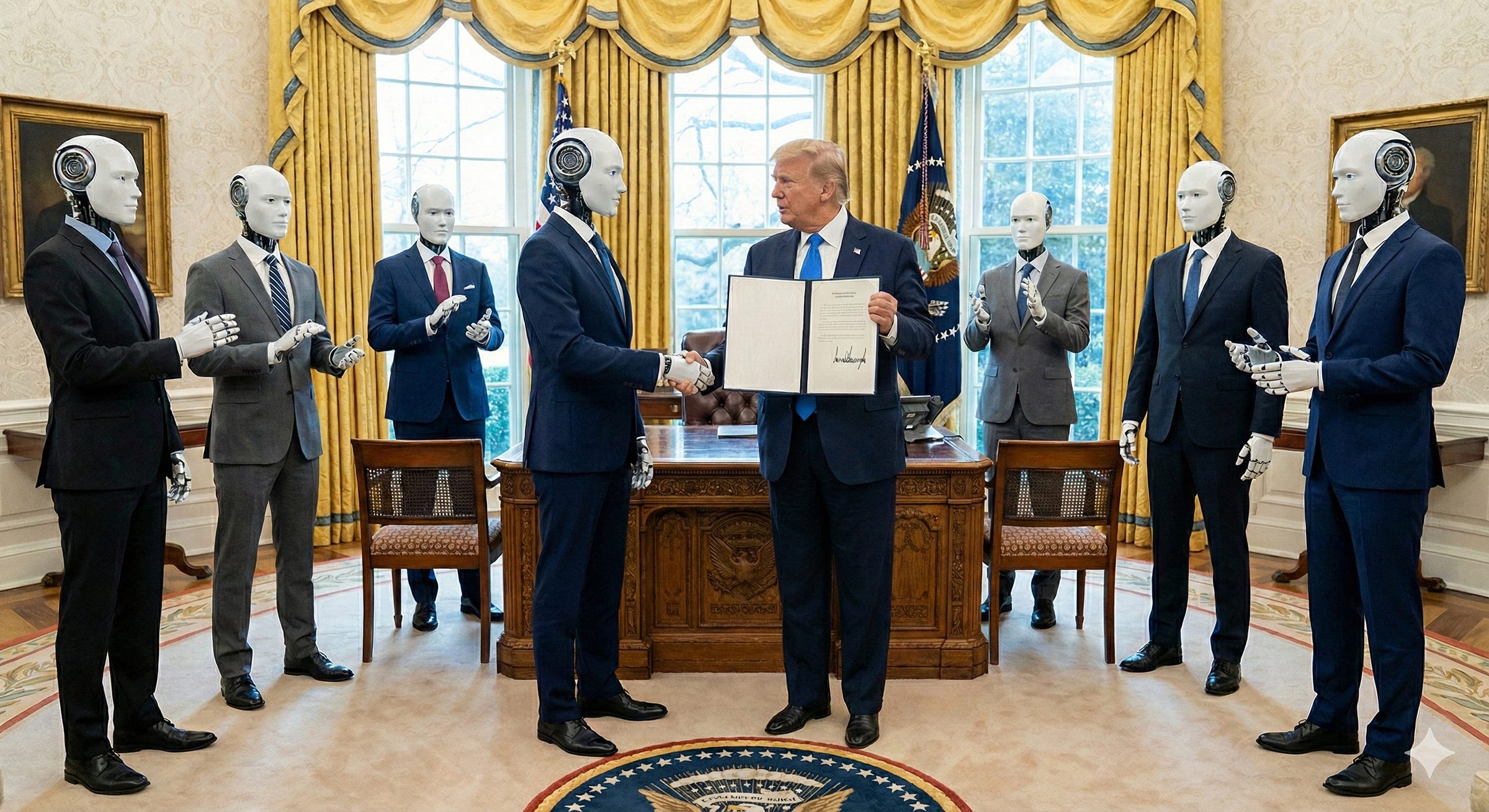Executive Order Launches “Genesis Mission”: A Manhattan Project for AI-Driven R&D
AI-centric Intellectual Property
On November 24, 2025, President Donald J. Trump signed an Executive Order establishing the “Genesis Mission,” a directive aimed at securing American leadership in artificial intelligence and scientific discovery. The Order describes the initiative as a “historic national effort, comparable in urgency and ambition to the Manhattan Project” (Sec. 1). For intellectual property (IP) owners, inventors, counsel, and IP stakeholders, this mandate signals a massive shift in federal research priorities, explicitly linking “global technology dominance” (Sec. 1) to the integration of AI in scientific workflows.
The Order mandates the creation of a centralized infrastructure to “unleash a new age of AI-accelerated innovation” (Order, Sec. 1), raising immediate questions regarding data rights, inventorship of AI-generated assets, and the security of proprietary information shared with the government.
The American Science and Security Platform
The cornerstone of this initiative is the “American Science and Security Platform” (the Platform), which the Secretary of Energy is directed to establish. This Platform will serve as the “infrastructure for the Mission” and aims to integrate federal and private resources (Sec. 3(a)).
The Platform is tasked with providing several critical capabilities:
Computing Power: Access to “DOE national laboratory supercomputers and secure cloud-based AI computing environments” designed for “large-scale model training, simulation, and inference” (Sec. 3(a)(i)).
AI Agents: The deployment of “AI agents to explore design spaces, evaluate experimental outcomes, and automate workflows” (Sec. 3(a)(ii)).
Data Integration: A repository containing “proprietary, federally curated, and open scientific datasets” (Sec. 3(a)(v)).
IP-conscious folks should note the explicit inclusion of “synthetic data generated through DOE computing resources” (Sec. 3(a)(v)). This reliance on synthetic data—data created by AI rather than direct observation—introduces specific validation challenges for resulting inventions.
Collaboration and Intellectual Property Frameworks
Section 5 provides the most significant directives for the legal and IP communities. The Order directs the Secretary of Energy to facilitate partnerships with external entities that possess “advanced AI, data, or computing capabilities or scientific domain expertise” (Sec. 5(c)).
However, participation comes with strict regulatory oversight. The Secretary must “develop standardized partnership frameworks” (Sec. 5(c)(i)) and, critically, establish “clear policies for ownership, licensing, trade-secret protections, and commercialization of intellectual property developed under the Mission” (Sec. 5(c)(ii)).
The Order explicitly anticipates non-human contributions to innovation, referencing “innovations arising from AI-directed experiments” (Sec. 5(c)(ii)). This language suggests the Administration is preparing for scenarios where AI agents, as described in Section 3(a)(ii), are the primary drivers of patentable subject matter.
Furthermore, the mandate requires “uniform and stringent data access and management processes” for non-federal collaborators (Sec. 5(c)(iii)). These measures will include “compliance with classification, privacy, and export-control requirements,” creating a complex compliance environment for private sector participants (Sec. 5(c)(iii)).
Analysis: Benefits, Challenges, and Risks
While the Genesis Mission offers substantial resources for R&D, legal counsel must carefully evaluate the terms of engagement.
Benefits:
Acceleration of Discovery: By utilizing “AI agents to test new hypotheses” (Sec. 1), the Mission aims to “achieve dramatic acceleration in AI development and utilization” (Sec. 1). This could significantly shorten R&D lifecycles for participants.
Infrastructure Access: The Platform provides “high-performance computing resources” (Sec. 3(a)(i)) that might otherwise be cost-prohibitive for smaller entities or universities.
Standardization: The requirement for “digitization, standardization, metadata, and provenance tracking” (Sec. 3(d)(i)) could lead to higher quality, more interoperable scientific datasets.
Challenges and Risks:
Confidentiality and Trade Secrets: The Platform intends to host “proprietary... datasets” (Sec. 3(a)(v)). While the Order calls for “trade-secret protections” (Sec. 5(c)(ii)), consolidating high-value corporate data on a government platform creates a centralized target. Any breach could expose sensitive IP. Counsel must scrutinize the “risk-based security measures” (Sec. 5(a)(iii)) before advising clients to upload proprietary data.
AI Hallucinations and Data Integrity: The reliance on “synthetic data generated through DOE computing resources” (Sec. 3(a)(v)) poses a risk of “hallucinations”—where the AI generates plausible but false data. If “AI-enabled predictive models” (Sec. 3(a)(iii)) form the basis of a legal document (e.g., a patent application, contract), and the underlying data proves faulty, the validity of the document could be jeopardized.
Inventorship Ambiguity: The Order’s reference to “innovations arising from AI-directed experiments” (Sec. 5(c)(ii)) clashes with current USPTO guidance, which generally requires human inventorship. If an AI agent on the Platform independently solves a “national science and technology challenge” (Sec. 4(a)), determining ownership between the software developer, the user, and the federal government will be legally complex.
Regulatory Compliance: Collaborators must adhere to “export-control requirements” and “classification” standards (Sec. 5(c)(iii)). This adds a layer of liability for commercial entities unaccustomed to federal security protocols.
Conclusion
The Genesis Mission represents a “pivotal moment” (Sec. 1) in federal science policy, placing AI at the center of national strategy. The Administration intends to “multiply the return on taxpayer investment” (Sec. 1) through this consolidation of data and compute power.
For the IP community, the immediate task is to monitor the “standardized partnership frameworks” due from the Secretary of Energy. These documents will define the practical reality of “ownership... and commercialization” (Sec. 5(c)(ii)) within this new ecosystem.
Until those policies are published, IP owners should likely view the Platform with hopeful interest but maintain a guarded approach toward data sharing.
Disclaimer: This is provided for informational purposes only and does not constitute legal or financial advice. To the extent there are any opinions in this article, they are the author’s alone and do not represent the beliefs of his firm or clients. The strategies expressed are purely speculation based on publicly available information. The information expressed is subject to change at any time and should be checked for completeness, accuracy and current applicability. For advice, consult a suitably licensed attorney and/or patent professional.



